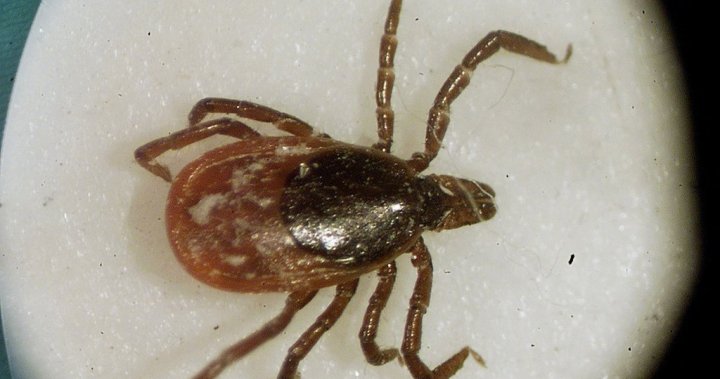The warming climate has encouraged the rise in Lyme disease and the introduction of lesser known tick-borne diseases, public health experts say.
“Climate change in Canada is happening at a much faster rate than you can see in some of the rest of the world,” said Heather Courtworth, head of field research at the National Institute of Microbiology in Winnipeg.
“All mites, which are eight-legged creatures, but common bugs, require a certain amount of heat and humidity to complete their lifecycle,” she said.

While Ontario, Quebec and Nova Scotia continue to be hotspots for black leg mites that can carry bacteria, parasites and viruses that cause human disease, changes in climate could lead to growth in mites in Manitoba, including Manitoba, Saskatchewan, Saskatchewan, Alberta and British Columbia.
Janet Sparring, a scientist specializing in the president of Bug and the Lyme Disease Foundation in Canada, said that means there is a need for increased awareness of tick-borne diseases, not just among the public, but also among the primary caregivers and infectious disease experts.
“Many doctors say this was their training. “You can't get Lyme disease in Alberta. If you don't have a history of travel, don't worry,” said Sparling, who lives in Edmonton.
“It's definitely changing and education isn't keeping up with some doctors,” she said.
More details on science and technology
An increase in tick-borne diseases doesn't mean you should stay inside, experts agree. But you can protect yourself. Here are some things you need to know about how to safely enjoy the illness and summer weather:
How common is Lyme disease?
Lyme disease has been on the rise in Canada and the US for several years. When the state's public health units began surveillance in 2009, they reported 144 cases nationwide. The preliminary case count for 2024 is 5,239, according to the Canadian Public Health Agency.
The real numbers are likely high, Courtworth said, as many people have very common symptoms and are likely to have never been diagnosed.
“If things continue to be like that and climate change keeps things moving forward, it is estimated that there will be around 500,000 cases of Lyme disease in Canada in 25 years,” she said.
What are the symptoms of Lyme disease?
Lyme disease can feel like many other diseases and can lead to fever, chills, fatigue, headaches, swelling lymph nodes, and pain in the muscles and joints.
One sign of Lyme disease is the bull's eyes, targets, or rash that appears to be round or oval.
However, Coatsworth warns that around 30% of infected people will not develop a rash, so if you have other symptoms, a diagnosis of Lyme disease should not be ruled out.

What are some other tick-borne diseases?

Get weekly health news
Receive the latest medical news and health information provided every Sunday.
Over the past few years, some states have begun surveillance for three other diseases that are spread by black-legged mites, anaplasmosis, babesiosis and pausanvirus.
Of those, anaplasmosis, still rare, appears to be growing at the fastest, Cotesworth said: “It's like a new kid on the block.”
When public health officials first began surveillance around 2012, there were around 10-50 cases per year in Canada.
Courtworth said there were more than 700 cases of anaplasmosis reported last year.
“It really speeds up within the population.”
Symptoms of anaplasmosis may resemble Lyme disease, which does not have a rash. Cough, diarrhea, abdominal pain and vomiting can also be included, according to the Canadian Public Health Agency.
Babesiosis can also cause similar symptoms to Lyme disease without rash, but it often causes anemia, Coteworth said.
The Powassan virus can cause fever, chills, headaches, vomiting, and general debilitating, but often progresses to serious neurological symptoms such as encephalitis (brain swelling) and meningitis.
Can these diseases be treated?
Lyme disease and anaplasmosis are both caused by bacteria and can be treated with antibiotics that usually begin with doxycycline, Cotesworth said.
Babesiosis is caused by parasites and resembles malaria, she said. It can be treated with antiparasitic drugs.
There is no cure for the Powassan virus. Patients are treated with supportive care. This can include intravenous fluid, medication, and respiratory aids to reduce brain swelling.

What mites carry these diaseases?
Two types of black leg ticks have these diseases. Ixodes scapularis is found in several parts of Canada, particularly Ontario, Quebec and Nova Scotia. In parts of British Columbia, the dominant tick is Ixadespacifix, also known as the West Black Leg Mite.
Mites feed on the blood of deer, mice, rabbits, and other mammals, as well as the blood of birds and reptiles. Birds can carry long distance mites, allowing them to transport them to various parts of Canada. If the host animal is infected, the mites become infected and they transmit the disease to the human when they bite and latch.
What do ticks look like?
“A lot of people are very surprised when I showed them black leg ticks. They can't believe how small they are,” said Dr. Curtis Russell, an expert on vector-borne diseases in Public Health Ontario.
Non-bloody adult ticks are the size of sesame seeds. Young ticks are the size of poppies.
Trend now

Celebrities arrive in Venice for Jeff Bezos' wedding

Trump says we will “effective immediately” to end trade talks with Canada
Where are the mites?
According to the Canadian Public Health Agency, mites are located in wooded, grassy areas.
That includes forests, parks and hiking trails, but mites can also live in more populated areas, Courtworth said.
“(It's) a lot about the animals that exist in these environments. So many of them are spaces around the city, and now they're like spaces that are probably a local neighborhood park with more squirrels.
How can I prevent mites from biting?
Preventing mites from bites is like repelling mosquitoes, said Dr. Mayank Singal, a public health doctor at the BC Centers for Disease Control and Prevention.
The use of long sleeves, long pants and bug spray is all important measures. It's best to choose brightly colored clothing. Because it's easy to spot mites when they land.
Singal also encourages “to try to avoid contact with leaves and bushes, because it's usually how they latch.”
Russell means that it means hiking and staying in the middle of the trail.
After outdoor activities, a tick check of the whole body, including parts of the body that are not exposed. Russell suggested taking a bath or shower.
“You can check all the areas where there may have been mites and if they haven't been bitten by you yet… they can probably wash them off,” Russell said.
“They usually tend to bite the hairline, underarms, behind the legs and gro diameter before biting.”
Russell also recommends washing clothes and placing clothes in a dryer where high fever kills mites.

If a mites are found, do I need to remove them?
yes. Experts agree to do it with tweezers as soon as possible.
The tick has its mouth embedded in the skin, like its legs sticking out, and it is important to remove all the mites.
“I want to grab it as close as possible to the edge of my skin, squeeze the tweezers, grab the tick and pull it straight,” Singal said.
“We don't want to twist. We don't want to go left and right. Pull straight and try to get everything out as much as possible.”
It takes about 24 hours for the tick to absorb Lyme disease, anaplasmosis, or babesiosis.
According to the Canadian Public Health Agency, Pausan virus can be sent quickly 15 minutes after attachment, but there are currently few mites carrying the virus.

So what?
People can take photos of the tick and submit it to eTick.ca. Operated by several universities and public health agencies, the service tells you what tick-and-tick-borne risks are in the area.
If you have mites on you and you begin to develop symptoms, meet your healthcare provider and let them know that you may be exposed to a tick-borne illness, Russell said.
The report, which was first published on June 28, 2025, by Canadian report.
Health insurance for Canadian news outlets is supported through a partnership with the Canadian Medical Association. CP is solely responsible for this content.
Curator Recommendations

The ultimate guide to vitamins and supplements

Best Concealer for Crowds of 40+ People

